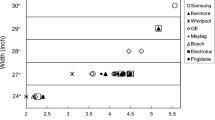Abstract
Product family optimization involves not only specifying the platform from which the individual product variants will be derived, but also optimizing the platform design and the individual variants. Typically these steps are performed separately, but we propose an efficient decomposed multiobjective genetic algorithm to jointly determine optimal (1) platform selection, (2) platform design, and (3) variant design in product family optimization. The approach addresses limitations of prior restrictive component sharing definitions by introducing a generalized two-dimensional commonality chromosome to enable sharing components among subsets of variants. To solve the resulting high dimensional problem in a single stage efficiently, we exploit the problem structure by decomposing it into a two-level genetic algorithm, where the upper level determines the optimal platform configuration while each lower level optimizes one of the individual variants. The decomposed approach improves scalability of the all-in-one problem dramatically, providing a practical tool for optimizing families with more variants. The proposed approach is demonstrated by optimizing a family of electric motors. Results indicate that (1) decomposition results in improved solutions under comparable computational cost and (2) generalized commonality produces families with increased component sharing under the same level of performance.
Similar content being viewed by others
References
Akundi S, Simpson TW, Reed PM (2005) Multi-objective design optimization for product platform and product family design using genetic algorithms. ASME design engineering technical conferences—design automation conference. Long Beach, CA
de Weck O (2005) Determining product platform extent. In: Simpson TW, Siddique Z, Jiao J (eds) Product platform and product family design: methods and applications. Springer, New York, pp 241–301
Deb K (2001) Multi-objective optimization using evolutionary algorithms. Wiley, Chichester, West Sussex, UK
Deb K, Agrawal S, Pratap A, Meyarivan T (2000) A fast elitist non-dominated sorting genetic algorithm for multi-objective optimization: NSGA-II. Parallel problem solving from nature VI conference. Paris, France, pp 849–858
Fujita K (2002) Product variety optimization under modular architecture. Comput Aided Des 34(12):953–965
Fujita K, Yoshida H (2001) Product variety optimization: simultaneous optimization of module combination and module attributes. ASME design engineering technical conferences—design automation conference. Pittsburgh, PA
Hassan R, de Weck O, Springmann P (2004) Architecting a communication satellite product line. In: 22nd AIAA international communications satellite systems conference & exhibit (ICSSC). Monterey, CA
Khajavirad A, Michalek JJ (2008a) A decomposed approach for solving the joint product family platform selection and design. Mech Des v130 p071101
Khajavirad A, Michalek JJ (2008b) A deterministic Lagrangian-based global optimization approach for large scale decomposable problems. In: ASME international design engineering technical conferences & computers and information in engineering conference IDETC/CIE. ASME, New York, USA
Khajavirad A, Michalek JJ, Simpson TW (2007) A decomposed genetic algorithm for solving the joint product family optimization problem. In: 3rd AIAA multidisciplinary design optimization specialists conference. Honolulu, HI
Khire RA, Messac A, Simpson TW (2006) Optimal design of product families using Selection-Integrated Optimization (SIO) Methodology. In: 11th AIAA/ISSMO symposium on multidisciplinary analysis and optimization. Portsmouth, VA
Kokkolaras M, Fellini R, Kim HM, Michelena NF, Papalambros PY (2002) Extension of the target cascading formulation to the design of product families. Struct Multidisc Optim 24(4):293–301
Kumar D, Chen W, Simpson TW (2006) A market-driven approach to the design of platform-based product families. In: AIAA/ISSMO multidisciplinary analysis and optimization conference. Portsmouth, VA
Martin M, Ishii K (1996) Design for variety: a methodology for understanding the costs of product proliferation. In: Design theory and methodology—DTM’96. Irvine, CA
Messac A, Martinez MP, Simpson TW (2002) Effective product family design using physical programming. Eng Optim 34(3):245–261
Michalek JJ, Ceryan O, Papalambros PY, Koren Y (2006a) Balancing marketing and manufacturing objectives in product line design. J Mech Des 128(6):1196–1204
Michalek JJ, Ceryan O, Papalambros PY, Koren Y (2006b) Balancing marketing and manufacturing objectives in product line design. ASME J Mech Des 128(6):1196–1204
Pacheco P (1997) Parallel programming with MPI. Morgan Kaufmann, San Francisco, CA
Simpson TW (2005) Methods for optimizing product platforms and product families: overview and classification. In: Simpson TW, Siddique Z, Jiao J (eds) Product platform and product family design: methods and applications. Springer, New York, pp 133–156
Simpson TW, D’Souza BS (2004) Assessing variable levels of platform commonality within a product family using a multiobjective genetic algorithm. Concurr Eng Res Appl 12(2):119–129
Simpson TW, Maier JRA, Mistree F (1999) A product platform concept exploration method for product family design. In: Design theory and methodology—DTM‘99. Las Vegas, Nevada
Simpson TW, Maier JRA, Mistree F (2001) Product platform design: method and application. Res Eng Des 13(1):2–22
Thevenot HJ, Simpson TW (2006) Commonality indices for product family design: a detailed comparison. J Eng Des 17(2):99–119
Author information
Authors and Affiliations
Corresponding author
Additional information
A preliminary version of this paper was presented at the 2007 AIAA Multidisciplinary Design Optimization Specialists Conference.
Rights and permissions
About this article
Cite this article
Khajavirad, A., Michalek, J.J. & Simpson, T.W. An efficient decomposed multiobjective genetic algorithm for solving the joint product platform selection and product family design problem with generalized commonality. Struct Multidisc Optim 39, 187–201 (2009). https://doi.org/10.1007/s00158-008-0321-9
Received:
Revised:
Accepted:
Published:
Issue Date:
DOI: https://doi.org/10.1007/s00158-008-0321-9




